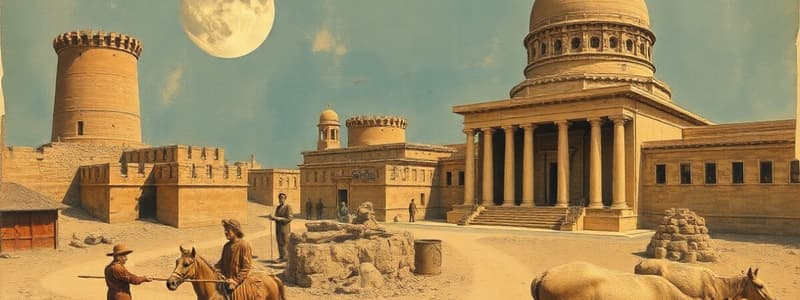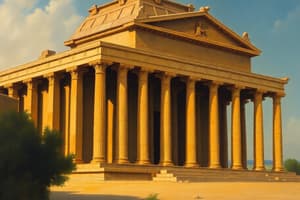Podcast
Questions and Answers
What architectural feature is a defining characteristic of the Tomb of the Shields and Chairs, setting it apart from earlier tombs?
What architectural feature is a defining characteristic of the Tomb of the Shields and Chairs, setting it apart from earlier tombs?
- The inclusion of furniture and rooms (correct)
- The resemblance to a hut
- The presence of a curved roof
- The use of terracotta figures
Which Etruscan tomb illustrates a clear departure from Greek artistic styles?
Which Etruscan tomb illustrates a clear departure from Greek artistic styles?
- The Tomb of the Leopards
- The Tomb of the Bulls
- The Sarcophagus of the Spouses (correct)
- The Tomb of the Augurs
How do the fresco paintings in Etruscan tombs, such as the Tomb of the Bulls, differ from the paintings found in Greek tombs?
How do the fresco paintings in Etruscan tombs, such as the Tomb of the Bulls, differ from the paintings found in Greek tombs?
- Etruscan tombs showcase scenes of nature and sexuality, unlike Greek tombs, which focus on idealized figures. (correct)
- Etruscan tomb paintings depict idealized figures, while Greek tombs feature more realistic scenes.
- Etruscan tombs are painted with a brighter palette, while Greek tombs are characterized by muted colors.
- Etruscan tombs feature more mythological themes, while Greek tombs depict everyday life.
What does the presence of wide roads in Marzabotto, an Etruscan city, suggest?
What does the presence of wide roads in Marzabotto, an Etruscan city, suggest?
What is the significance of the Palatine Huts?
What is the significance of the Palatine Huts?
Which element exemplifies the Roman's influence based on the Etruscan civilization?
Which element exemplifies the Roman's influence based on the Etruscan civilization?
What is the primary function of the Basilica in Roman cities?
What is the primary function of the Basilica in Roman cities?
What was the significance of the Roman Forum, as described in the provided content?
What was the significance of the Roman Forum, as described in the provided content?
What was a notable design element of the House of the Vettii?
What was a notable design element of the House of the Vettii?
What is the difference between the first and second style of Roman painting?
What is the difference between the first and second style of Roman painting?
Which Roman structure exemplifies the use of barrel vaults?
Which Roman structure exemplifies the use of barrel vaults?
What was the main purpose of the Alexander Mosaic?
What was the main purpose of the Alexander Mosaic?
Which type of Roman concrete was used to construct the Pantheon?
Which type of Roman concrete was used to construct the Pantheon?
What architectural feature is considered most significant in demonstrating the advanced nature of Roman engineering?
What architectural feature is considered most significant in demonstrating the advanced nature of Roman engineering?
What is a distinctive feature of the Roman House of the Faun?
What is a distinctive feature of the Roman House of the Faun?
How might the Roman Amphitheater in Pompeii be interpreted?
How might the Roman Amphitheater in Pompeii be interpreted?
What is the primary difference between the Doric and Ionic orders in Greek architecture?
What is the primary difference between the Doric and Ionic orders in Greek architecture?
What is the significance of the "Nestor Cup" discovered in Pithekoussai?
What is the significance of the "Nestor Cup" discovered in Pithekoussai?
Which of the following features is NOT characteristic of the Villanovan culture?
Which of the following features is NOT characteristic of the Villanovan culture?
What is the significance of the shift in architectural style observed at Satricum in the Archaic period (550 BCE)?
What is the significance of the shift in architectural style observed at Satricum in the Archaic period (550 BCE)?
What is the significance of the Tomb of the Diver in Paestum?
What is the significance of the Tomb of the Diver in Paestum?
Which of the following best describes the relationship between the Etruscan and Villanovan cultures?
Which of the following best describes the relationship between the Etruscan and Villanovan cultures?
Which of the following is NOT an architectural element found in the Doric order of Greek temples?
Which of the following is NOT an architectural element found in the Doric order of Greek temples?
What is the primary source of information used to study the human past in archaeology?
What is the primary source of information used to study the human past in archaeology?
Flashcards
Archaeology
Archaeology
The study of the human past, based on material remains.
Material Culture
Material Culture
Art, architecture, artifacts, and ecofacts that reflect a society's culture.
Doric Order
Doric Order
An architectural style featuring simple capitals and triglyphs.
Sorigenti della Nova
Sorigenti della Nova
Signup and view all the flashcards
Etruscans
Etruscans
Signup and view all the flashcards
Nestor Cup
Nestor Cup
Signup and view all the flashcards
Villanovan Culture
Villanovan Culture
Signup and view all the flashcards
Tomb of the Diver
Tomb of the Diver
Signup and view all the flashcards
Amphitheater
Amphitheater
Signup and view all the flashcards
House of Sallust
House of Sallust
Signup and view all the flashcards
Alexander Mosaic
Alexander Mosaic
Signup and view all the flashcards
Opus vermiculatum
Opus vermiculatum
Signup and view all the flashcards
Barrel vault
Barrel vault
Signup and view all the flashcards
Roman concrete (opus caementicium)
Roman concrete (opus caementicium)
Signup and view all the flashcards
Pantheon
Pantheon
Signup and view all the flashcards
The Pont du Gard
The Pont du Gard
Signup and view all the flashcards
Tomb of the Hut
Tomb of the Hut
Signup and view all the flashcards
Sarcophagus of the Spouses
Sarcophagus of the Spouses
Signup and view all the flashcards
Tarquinia
Tarquinia
Signup and view all the flashcards
Tomb of the Bulls
Tomb of the Bulls
Signup and view all the flashcards
Palatine Huts
Palatine Huts
Signup and view all the flashcards
Cloaca Maxima
Cloaca Maxima
Signup and view all the flashcards
Capitolium
Capitolium
Signup and view all the flashcards
Basilica
Basilica
Signup and view all the flashcards
Study Notes
Archaeology and Material Culture
- Archaeology is the study of the human past, using material remains.
- Material culture encompasses art, architecture, artifacts, and ecofacts.
- Italy's geography influenced settlement patterns: Etruscans in the north, Villanovans in the far north, Latins in the middle, and Greeks in the south.
Geography of Italy and Ancient Cultures
- Early Italian settlements included the Sorgenti della Nova huts in Etruria (made of waddle and daub), dating to around 11th-10th century BCE.
- The Villanovan culture (900-700 BCE) had its own distinct material culture, including urns (biconical and hut-shaped), social hierarchies, religious beliefs, trade, and wealth.
- The Orientalizing period (700-600 BCE) saw an increase in wealth and trade, reflected in artistic styles inspired by Near Eastern art.
- Satricum, a Latin town, transitioned from a Latin style to a Greek style in the Archaic period (550 BCE).
Architectural Terms
- Cella: The room containing the statue of a deity.
- Column: Vertical support beams.
- Capital: Top of the column.
- Frieze: A flat band below the triangular roof.
- Triglyph: A carving of three lines on the frieze (in Doric style).
- Metope: The space between triglyphs (in Doric style).
- Pediment: A triangular structure that forms the front of a building.
Temples and Architecture
- The Temple of Hera II/Apollo at Paestum (460 BCE) demonstrates Greek influence, featuring a Doric temple.
- Temple C at Selinus (540-530 BCE) is a Doric temple with carvings, depicting mythological scenes such as Perseus beheading Medusa and Herakles stringing up cercopid.
Tombs and Funerary Practices
- The Tomb of the Diver at Paestum features Greek paintings on the ceiling, scenes of a diver or swimmer.
- Etruscan tombs in Tarquinia displayed diverse artistic styles, some resembling houses.
- The Banditaccia Necropolis at Cerveteri (7th–2nd c BCE) included various types of tombs, reflecting changing burial practices.
- The Tomb of the Shields and Chairs (550-500 BCE) in Cerveteri served as a house-like model.
- The Tomb of the Bulls (530 BCE) in Tarquinia portrays scenes with mythological figures and animals.
Roman Civilization
- Roman Forum (625-600 BCE): an area between hills that became a public space.
- Cloaca Maxima: a drainage system reducing swampy conditions.
- The Servian Wall: a wall constructed to protect Rome.
- Roman Colony Examples like Luna: demonstrate orthogonal planning (grid layouts).
Building Materials and Techniques
- Roman concrete (opus caementicium) was used extensively for buildings like aqueducts and the Pantheon.
- Different types of stonework (opus incertum, reticulatum, testaceum) were employed for building façades.
- Water systems, including aqueducts, were crucial for the cities.
- The Fountain with water tower (Pompeii) regulated pressure to public fountains.
Architectural Styles
- Corinthian columns: found in theaters and other large-scale structures.
- Amphitheater: Used for gladiatorial contests, demonstrated the importance of these events to the community.
- Theatre and Covered theatre: Huge outdoor spaces designed for plays and other events.
Studying That Suits You
Use AI to generate personalized quizzes and flashcards to suit your learning preferences.



